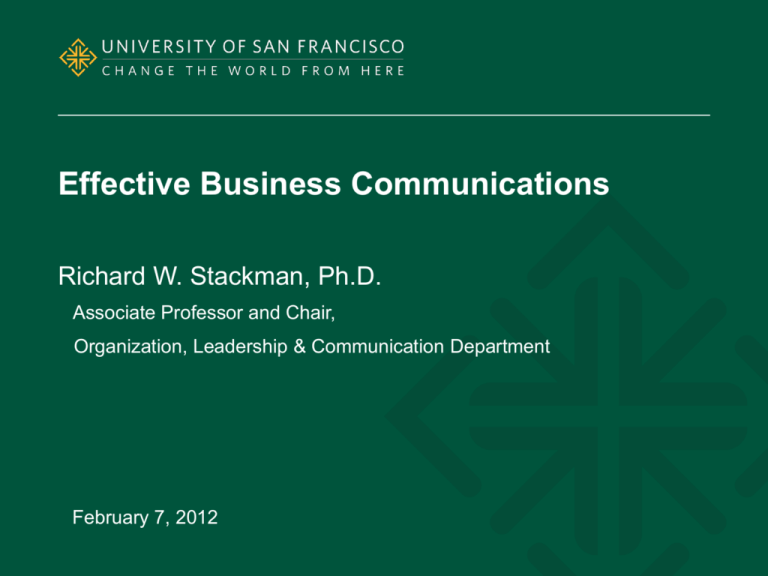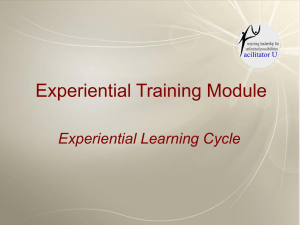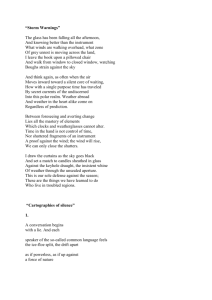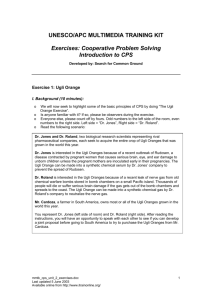Effective Business Communications
advertisement

Effective Business Communications Richard W. Stackman, Ph.D. Associate Professor and Chair, Organization, Leadership & Communication Department February 7, 2012 Desired Outcomes Improved skill development with respect to communicating: • Expression/Tone. • Written Documents (including e-mail). • Presentations. • Meetings. Initial Thoughts about Communication • Your development will be ongoing. • Listen and reflect more. Speak less. • Attempt to keep all communication short and concise. • Decide whether you really want what you communicate recorded. • Use a good copy editor. ___________________ • There is a difference between candor and transparency. • Many attempts to communicate effectively will be in vain. Key Topics • Organizational Context. • Discussion and Dialogue (including Constructive Conflict). • Credibility. • Trust. • Emotional Competence. • Silence. • Issue Selling. Organization Contexts • Dis-society—where it is every person for him or herself. • Dysfunctional—where the place is so political that one has to protect him or herself. • Functional—where one does his/her part, and as long as one is left alone, s/he is ok. • Formative—for the most part people cooperate; there is a fair amount of trust where one can usually say what is on his/her mind. • Community—where people can be themselves; everyone is viewed as important; our differences make us better. ‘Community’ Qualities • Authentic communication. • Respectful inclusion. • Honesty. • Listening is present. • One feels safe, connected. • Silence is reflective and energizing. • Appropriate vulnerability. Instructions: Ugli Orange Exercise • You will be playing one of two roles – either Dr. Jones or Dr. Roland. • Read your confidential instructions. • Find a counterpart – e.g., if you are Dr. Roland find a Dr. Jones – to talk with. Please choose a counterpart you do not know. • Finalize a bid for Mr. Cardoza (Richard). Bidding for the Ugli Oranges Debrief: Ugli Orange Exercise • How successful were you in creating a context reflective of ‘community’? ‘Community’ Qualities • Authentic communication. • Respectful inclusion. • Honesty. • Listening is present. • One feels safe, connected. • Silence is reflective and energizing. • Appropriate vulnerability. Debrief: Ugli Orange Exercise • How successful were you in creating a context reflective of ‘community’? • Did you focus on common interests? Did you become mired in addressing assumptions, using general, instead of specific, cases to make a point? Discussion vs. Dialogue • Discussion – is the way most people communicate. We present our ideas and everyone analyzes and dissects them from their points of view. The purpose of discussion is to make sure we win, or that our point of view is the one accepted. • Dialogue – is the exploration of ideas. During dialogue everyone works together contributing towards the idea (or goal). No one is trying to win; instead, we are trying to learn and create. Dialogue • Listen and speak without judgment. • Speak only for yourself, truthfully. • Acknowledge the speaker and respect differences. • Suspend certainties. • Suspend role and status importance. • Focus on learning from your counterpart. • Seek next level of understanding in order to expand the inquiry. • Release need for specific outcomes. • Balance speaking and listening. • Remember to operate in a mode of inquiry. Debrief: Ugli Orange Exercise • How successful were you in creating a context reflective of ‘community’? • Did you focus on common interests? Did you become mired in addressing assumptions, using general, instead of specific, cases to make a point? • How much conflict was evident throughout the conversation? Constructive Conflict • Domination—a victory of one side over the other. • Compromise—each side gives up a little in order to have peace. (Note: Compromise is the accepted way to end controversy even though one likely doesn’t want to compromise). • Integration—a discovered solution where the desires of both are identified so that neither has to sacrifice anything. It involves invention through not letting one’s thinking stay within the boundaries of two alternatives which are mutually exclusive. Espoused Theories vs. Theories-in-Use Espoused Theory (Productive Reasoning) • Seek valid (testable) information. • Create informed choice. • Monitor vigilantly to detect and correct errors. Theory-in-Use (Defensive Reasoning) • Be in unilateral control. • Win and do not lose. • Suppress negative feelings. • Behave rationally. Debrief: Ugli Orange Exercise • How successful were you in creating a context reflective of ‘community’? • Did you focus on common interests? Did you become mired in addressing assumptions, using general, instead of specific, cases to make a point? • How much conflict was evident throughout the conversation? • Did you establish credibility? Was trust evident from the very start? Did trust develop over time? Credibility • Competence—the degree of expertise, qualification, authoritativeness, and skill a person demonstrates. • Objectivity—the ability to look at multiple sides of an issue; to suspend personal biases; to be reasonable and dispassionate; to examine evidence and value questions before taking sides. • Co-orientation—the sense of similarity perceived by others; concern for the well-being of others; and a sense of shared interests, values, objectives, and needs. Credibility [continued] • Dynamism—refers to vigor and intensity with which an individual gets and maintains other people’s interests; includes how compelling one’s points are. • Trustworthiness—the consistency and honesty of an individual’s behavior; it is other’ confidence in an individual’s ability to be sincere and behave ethically even under pressure. Trust Trust is the foundation for social order, and thus critical to communication. Within the same relationship we have different encounters in different contexts with different intentions that lead to different outcomes. Because relationships are multifaceted, it is possible for individuals to simultaneously trust and distrust one another. You must develop the capacity to manage the ways in which you are trusted and distrusted by others. Fundamental Attribution Error In explaining the behavior of others (but not ourselves), people have the tendency to over-value dispositional or personality-based explanations while undervaluing situational explanations for those behaviors. Debrief: Ugli Orange Exercise • How successful were you in creating a context reflective of ‘community’? • Did you focus on common interests? Did you become mired in addressing assumptions, using general, instead of specific, cases to make a point? • How much conflict was evident throughout the conversation? • Did you establish credibility? Was trust evident from the very start? Did trust develop over time? • Was there evidence of equality, empathy, and openness in your conversation? From the outset to the end? Emotional Competence Self-Awareness Social Awareness The ability to accurately perceive your own emotions and stay aware of them as they happen. This includes keeping on top of how you tend to respond to specific situations and people. The ability to accurately pick up on emotions in other people and get what is really going on. This often means understanding what other people are thinking and feeling even if you don’t feel the same way. Self-Management Relationship Management The ability to use awareness of your emotions to stay flexible and positively direct your behavior. This means managing your emotional reactions to all situations and people. The ability to use your awareness and the emotions of others to manage interactions successfully. This includes clear communication and effectively handling conflict. Mid-Presentation Summary • Organizational Context. • Dialogue and Integration. -- Congruence between Espoused Theories and Theories-in-Use. • Credibility. • Trust. -- Avoid the Fundamental Attribution Error. • Emotional Competence. Silence Silence is defined as the withholding of any form of genuine expression about the individual’s behavioral, cognitive and/or affective evaluations of his or her organizational circumstances to person who are perceived to be capable of effecting change or redress. Silence does not equate to loyalty, nor endorsement of the status quo. It not only may signify objection and dissent, but that it may also result from a lack of information, an absence of voice opportunities, and a belief that voicing would be futile or dangerous. Breaking Silence To voice is any attempt at all to change rather than escape from objectionable state of affairs. • Should something be said? • Can something be said? Issue Selling • The process by which individuals attempt to influence others’ attention to and understanding of events, development, and trends. • It shapes the investment of time and attention and thereby shapes the actions and changes that ensue. • Note: People outside the ‘power structure’ are capable of being potent initiators of change. Issue Selling [continued] To ‘sell’ issues one needs to focus on three types of ‘moves’: • Process reflects the formality (with respect to written or oral communication), preparation, and timing (persistence, opportunism, and involvement of others). • Packaging involves the presentation of an issue and its bundling with other issues or goals. • Involving refers to key organizational members who can increase the visibility and help grow a powerful coalition. Desired Outcome(s) Improved skill development with respect to communicating: • Expression/Tone. • Written Documents (including e-mail). • Presentations. • Meetings (including presence). • Social Media. Bibliography C. Argyris. 2010. Organizational traps: Leadership, culture, organization design. Oxford, England: Oxford. N.M. Ashkanasy & C.S. Daus. 2002. Emotion in the workplace: The new challenge for managers. Academy of Management Executive. J.E. Dutton, S.J. Ashford, R.M. O’Neill, & K.A. Lawrence. 2000. Moves that matter: Issue selling and organizational change. Academy of Management Journal, 44: 716-736. M.P. Follett. 1925. Constructive Conflict. In P. Graham (Ed.), Mary Parker Follett: Prophet of management. Boston, MA: Harvard Business School Press. J.R. Katzenbach & D.K. Smith. 1993. The discipline of teams. Harvard Business Review. D. Krackhardt & J.R. Hanson. 1993. Informal networks: The company behind the chart. Harvard Business Review. R.J. Lewicki, D.J. McAllister, and R.J. Bies. 1998. Trust and distrust: New relationships and realities. Academy of Management Review, 23: 438-458. J.M. Nowakowski & D.E. Conlon. 2006. Organizational justice: Looking back, looking forward. International Journal of Conflict Management. 16: 4-29. L.D. Ordonez, M.E. Schweitzer, A.D. Galinsky & M.H. Bazerman. 2009. Goals gone wild: The systematic effects of overprescribing goal setting. Academy of Management Perspectives, 23(1): 6-16. C.C. Pinder & K.P. Harlos. 2001. Employee silence: Quiescence and acquiescence as responses to perceived injustice. Research in Personnel and Human Resources Management, 20: 331-369. L. Prusak & D. Cohen D. 2001. How to invest in social capital. Harvard Business Review. Bibliography [continued] R.W. Stackman & K. Devine. 2011. Leadership and “emotional-rational” coherence: A start? Academy of Management Perspectives, 42-44. K.E. Weick. 1993. The collapse of sensemaking in organizations: The Mann Gulch disaster. Administrative Science Quarterly, 38: 628-652. G. Zlevor. 1998. Creating a new workplace: Making a commitment to community. In. P. Senge et al. [eds.], The New Workplace. Waltham, MA: Pegasus.








